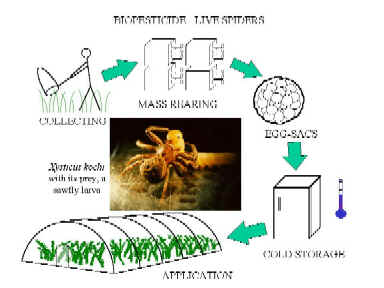- The problem
to be solved:
The commercial biopesticide arthropods are host
specific, therefore the combined use of different
species is necessary against the simultaneously
damaging thrips, mites and aphids. The applied
species, however, are sensitive and require
different microclimatic conditions.
|
- Definition:
Mass rearing of foliage dwelling spiders
collected in the field, storage and delayed
application of their egg-sacs against greenhouse
pests, especially thrips, spider mites and
aphids.
|
- Presentation:
Egg-sacs of foliage dwelling non
web-building spiders (e.g. Xysticus spp.,
Tibellus spp., Philodromus spp.) are placed into
beehive-like, closed breeding boxes. The inner
structure - covered with a removable material -
provides the spiders with a large surface within
a relatively small volume, in order to decrease
cannibalism. There are holes on one side of the
box, where changeable tubes - containing fruit
fly (Drosophila melanogaster) culture - are
connected to the box. The inner side of the box
is coated with Teflon, or with a Teflon-like
material that spiders are unable to climb so that
they cannot get into these tubes. From hatching
to egg-laying, spiders feed on fruit flies
emerging from the tubes. At the bottom of the box
there are larvae of flour-beetles (Tenebrio
molitor), which continuously clean up the dead
fruit flies, preventing the underlay from
mildewing. The maintenance of the breeding means
the regular change of tubes - containing old
cultures - to fresh ones. Simultaneously hatched
spiders become mature and breed at the same time
and attach their egg-sacs to the inner structure
of the box. Egg-sacs are removed from the box
together with the carrier surface and they are
kept on low temperature to postpone hatching
until application. Egg sacs are applied in
greenhouses. From each egg-sac, 50-70 spiderlings
(body length ca. 1 mm) emerge. Spiderlings
distribute evenly on the plants, and suppress or
eradicate populations of small-sized arthropods.
Since hunting spiders do not spin a web for
capturing prey, they do not pollute the plants
with detectable quantity of silk. The cheliceral
fang of these spiders – even of the adult
individuals - is extremely short and unable to
pierce human skin.

|
|
|
- Advantages:
The applied spiders are generalist predators and
effective against a wide range of pests. Their
egg-sacs are easy to store, handle, dose and
apply, and the spiderlings are not sensitive to
the fluctuation of temperature and humidity, and
the lack of food. These spiders are harmless to
man.
|
- Stage of
development:
Experimental application
|
- Documentation
available: Yes
|
The inventor(s)
- Name(s): Dr.
Ferenc Tóth, Khosbayar Bayar
- Self
introduction:
I was born in Miskolc (Hungary) in 1969. I
obtained my Ph.D. degree from the role of spiders
in pest control. I research and teach pest
management at the Szent István University,
Faculty of Agricultural and Environmental
Sciences, Department of Plant Protection,
Gödöllő. I was born in Ulaanbaatar (Mongolia)
in 1972. The theme of my diplomawork was the
application of rapeseed oil (TelmionR)
as a bioacaricide in viticulture. I work in
breeding of lucerne, soybean and chick-pea at the
Szent István University, 2 Fleischmann Rudolf2
Agricultural Research Institute in Kompolt.
|
The protection
- Form:
- Priority:
- Countries
where it is force:
|
| Business
intention: Search for sponsors and partners for
mass production |
Contact
- Name: Dr.
Ferenc Tóth
- E-mail: tothf@fau.gau.hu
- Fax: (36-28)
522077
- Address: H-2103
Gödöllő, Páter K. U. 1.
|